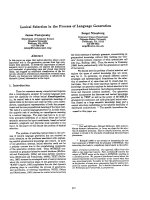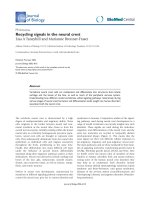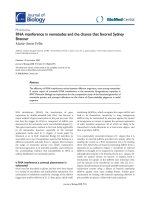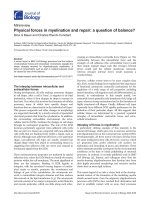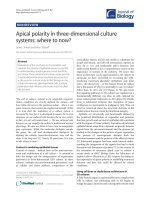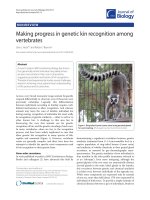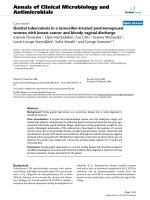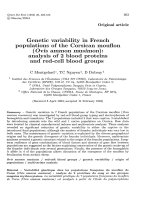Báo cáo sinh học: " Mass selection in livestock using limited testing facilities" pdf
Bạn đang xem bản rút gọn của tài liệu. Xem và tải ngay bản đầy đủ của tài liệu tại đây (500.17 KB, 9 trang )
Original
article
Mass
selection
in
livestock
using
limited
testing
facilities
L
Ollivier
Institut
National
de
la
Recherche
Agronomique,
Station
de
G6n6tique
Quantitative
et
Appliquee,
78350
Jouy-en-Josas,
France
(Received
29
May
1989;
accepted
20
September
1989)
Summary -
This
paper
considers
the
problem
of
maximizing
the
expected
annual
response
to
mass
selection
when
testing
facilities
are
limited
and
so
do
not
allow
testing
of
all
potential
candidates.
In
such
situations,
there
is
room
for
variation
both
in
the
proportion
of
breeding
animals
selected
on
the
basis
of
the
test
result "nd
in
the
allocation
of
testing
places
between
male
and
female
candidates.
When
testing
facilities
are
very
limited
(case
1), males
have
priority
in
testing
and
the
maximum
proportion
to
select
based
on
test
results
is
27%.
This
means
that
it
is
then
better
to
use
untested
males,
i.e.
taken
at
random,
than
males
which
are
in
the
lower
73%.
This
situation
holds
until
the
ratio
(k)
of
tested
to
potential
candidates
reaches
kl
=
1.85/c(4aA
+ 1),
where
c
is
the
degree
of
polygyny
(mating
ratio),
a
the
age
at
first
offspring
(yr)
and
À,
the
annual
fecundity
(s.e.
half
the
dam
progeny
crop).
As
k increases
above
kl
(case
2),
all
replacement
males
should
be
tested
and
testing
space
should
be
entirely
devoted
to
males,
with
random
choice
of
females.
This
situation
holds
until
k reaches
a
critical
value,
k2,
above
which
testing
space
should
be
equally
distributed
between
the
2
sexes
(case
3).
The
value
of
k2,
obtained
iteratively
for
any
given
set
of
parameters
c,
a
and
À,
as
defined
above,
is
shown
to
increase
when
c
increases
and
when
aA
decreases.
The
strategies
recommended,
which
imply
contrasting
turn-over
rates
between
selected
candidates
and
candidates
chosen
at
random,
are
compared
to
those
aimed
at
maximizing
selection
intensity
for
a
fixed
value
of
the
generation
interval.
Numerical
examples
are
provided,
covering
the
range
of
situations
prevailing
in
farm
livestock
species.
mass
selection
/
selection
response
/
selection
intensity
/
generation
interval
Résumé -
La
sélection
massale
chez
les
animaux
domestiques
avec
une
capacité
de
contrôle
limitée -
Cet
article
traite
de
la
maximisation
du
gain
génétique
annuel
attendu
en
sélection
massale
quand
la
capacité
de
contrôle
est
limitée
et
ne
permet
pas
de
contrôler
tous
les
candidats
potentiels
à
la
sélection.
Dans
une
telle
situation,
on
peut
faire
varier
à
la
fois
la
proportion
des
reproducteurs
sélectionnés
sur
leur
résultat
de
contrôle
et
la
répartition
des
places
de
contrôle
entre
les
2
sexes.
Quand
la
capacité
de
contrôle
est
restreinte
(cas
1),
les
mâles
ont
la
priorité
et
le
taux
de
sélection
maximal
à
l’issue
des
contrôles
est
de
27%.
Il
vaut
mieux
alors
utiliser
des
mâles
non
controlés,
c’est-à-dire
choisis
au
hasard,
que
des
mâles
se
trouvant
dans
les
73%
inférieurs.
Cette
situation
prévaut
tant
que
le
rapport
(k)
des
candidats
contrôlés
aux
candidats
potentiels
ne
dépasse
pas
kl
=
1,
85/c(4aλ+1),
où
c
est
1_e
degré
de
polygynie
(nombre
de
reproducteurs
femelles/nombre
de
reproducteurs
mâles),
à
l’âge
au
l
er
descendant
(an)
et ) g la fécondité
annuelle
(c’est-à-dire
la
moitié
du
nombre
de
descendants
produits
annuellement
par
femelle).
Quand
k
dépasse
ki
(cas 2)
tous
les
mâles
de
renouvellement
doivent
être
contrôlés
et
toutes
les
places
de
contrôle
doivent
être
réservées
aux
mâles,
les
femelles
étant
choisies
au
hasard.
Cette
situation
prévaut
jusqu’à
une
valeur
critique
k =
k2,
au-
dessus
de
laquelle
les
places
doivent
être
également
réparties
entre
les
2
sexes
(cas
3).
On
montre
que
cette
valeur
k2,
qui
est
obtenue
par
itération
pour
tout
ensemble
donné
des
paramètres
c,
a
et
À,
définis
ci-dessus,
augmente
avec
c
et
diminue
quand
aa
augmente.
Les
stratégies
recommandées,
qui
impliquent
des
taux
de
renouvellement
très
différents
entre
les
candidats
sélectionnés
et
les
candidats
choisis
au
hasard,
sont
comparées
à
celles
qui
visent
à
maximiser
l’intensité
de
sélection
à
intervalle
de
génération
fixé.
Des
exemples
sont
donnés
pour
illustrer
le
cas
des
diverses
espèces
animales
domestiques.
sélection
massale
/
réponse
à
la
sélection
/
intensité
de
sélection
/
intervalle
de
génération
INTRODUCTION
Mass
selection
is
a
simple
and
widely
used
selection
method
for
farm
animals.
Considering
a
trait
expressed
in
both
sexes,
and
following
a
normal
distribution,
the
expected
annual
response
can
be
shown
to
be
a
function
of
the
mean
ages
of
males
and
females
at
culling.
The
maximum
response
is
obtained
by
determining
an
optimal
balance
between
selection
intensities
and
generation
intervals,
as
shown
by
Ollivier
(1974)
for
the
case
when
all
potential
candidates
are
tested.
The
purpose
of
this
paper
is
to
extend
the
treatment
to
situations
where
testing
facilities
are
limited
and
so
do
not
allow
testing
of
all
potential
candidates.
In
such
cases,
there
is
room
for
variation
both
in
the
proportion
of
breeding
animals
selected
on
the
basis
of
the
test
resultgand
in
the
allocation
of
testing
places
between
male
and
female
candidates.
The
effect
of
such
a
variation
on
the
overall
selection
intensity
has
previously
been
considered
by
Smith
(1969).
The
general
method
Dickerson
and
Hazel
(1944)
gave
a
general
formula
for
the
expected
annual
response
to
selection,
Rd
=
(i
1
+
i2
)/(t
l
+
t2
),
as
a
function
of
female
and
male
selection
intensities
(i
l
and
i2
,’ respectively)
and
generation
intervals
(t
l,
t2
),
Ra
being
expressed
in
genetic
standard
deviations
for
a
trait
assumed
to
have
a
heritability
equal
to
1.
With
selection
of
respective
proportions
f
and
m
of
the
females
and
males
required
for
breeding,
and
corresponding
proportions
1 —
f
and
1 —
m
taken
at
random,
the
expected
annual
response
becomes:
where
t
ll
and
t
12
are
the
generation
intervals
for
the
females
selected
and
the
females
taken
at
random,
respectively,
and
t
21
and
t
22
are
similarly
defined
for
males.
&dquo;
If
selection
is
by
truncation
of
a
normal
distribution,
il
= z
lnl,
where
ni
is
the
number
of
female
candidates
tested
per
female
selected
and
zl
the
ordinate
of
the
normal
curve
for
a
proportion
1/n,
selected,
and
i2
is
similarly
defined.
Moreover,
generation
intervals
may
be
expressed
as
functions
of
demographic
parameters
pertaining
to
any
given
species,
and
of
the
distribution
of
testing
space
between
males
and
females.
Using
the
simple
demographic
model
assumed
by
Ollivier
(1974};
for
instance,
one
can
write:
-
where
a
is
the
parents’
age
(in
years)
at
birth
of
first
offspring,
assumed
equal
for
both
sexes;
c
is
the
degree
of
polygyny,
or
mating
ratio;
A
is
the
annual
female
fecundity,
referring
to
the
number
of
candidates
of
1
sex
(sex
ratio
assumed
to
be
1/2)
able
to
breed
successfully;
h
and
12
are
the
respective
numbers
of
female
and
male
candidates
tested
annually
per
dam.
Expressions
(2)
are
based
on
the
definition
taken
for
the
generation
interval,
which
is
assumed
to
be
the
arithmetic
mean
of
the
parents’
ages
at
birth
of
first
(a)
and
of
last
offspring.
The
latter
is
determined
by
the
time
necessary
to
replace
1
breeding
animal,
either
selected
among
n
candidates
or
taken
at
random.
For
instance,
knowing
that h
female
candidates
are
tested
annually
per
breeding
female,
ie,
Illf
candidates
per
female
selected,
and
that
each
selected
female
is
chosen
among
n1
candidates,
the
time
required
is
fnl/l1
years,
which
leads
to
eqn(2a).
On
the
other
hand,
(A - 11)
females
are
untested,
ie,
(À -1¡)/(1-
f)
per
female
chosen
at
random.
The
time
necessary
to
obtain
1
candidate,
if
one
takes
the
first
born,
is
(1 -
f)/(A -
11
),
which
leads
to
eqn(2b).
Equations
(2c)
and
(2d)
are
similarly
obtained.
Now
h
and
12
depend
on
the
overall
testing
capacity,
defined
as
the
proportion
k
of
available
candidates
which
can
be
tested
annually,
and
of
the
distribution
of
testing
places
between
females
and
males,
defined
by
the
sex
ratio
a
among
the
tested
candidates,
so
that:
The
possible
range
of
a
extends
from
0
to
1
as
long
as
k
<
0.5.
Then,
as
k
exceeds
0.5,
the
range
is
progressively
narrowed,
until
a =
0.5
when
k
=
1.
Case
1:
only
males
are
tested
(a
=
1);
a
proportion
(m
<
1)
of males
required
for
breeding
is
tested
In
this
case,
f
= h
=
0
and
12
=
2kA.
Expression
(1)
reduces
to
a
function
of
2
variables,
m
and
n2,
such
that:
with
The
maximum
of
R
’f
,)with
respect
to
m
is
obtained
for:
With
this
value
of
m,
Ra
becomes
a
quantity
approximately
proportional
to
z2
ng.
5,
which
is
maximum
for
n2
-
3.7.
Thus,
the
critical
value
of
k
for
which
m
=
l,,,is
from
eqn(5):
or,
with
n2
-
3.7,
Consequently,
when
testing
capacity
is
limited
to
a
value
k
<
ki,
a
proportion
of
untested
males
should
be
used,
in
order
to
maintain
a
constant
proportion
selected
of
about
27%
(1/3.7)
among
those
tested.
Under
these
conditions,
the
expected
annual
response
is
approximately
proportional
to
kl
-’,
as
Case
2:
only
males
are
tested
(a
=
1);
all
males
required
for
breeding
are
tested
(m =
1)
As k
becomes
equal
to
kl,
and
then
increases
above
kl,
m
=
1
and
eqn(4a)
reduces
to:
which
can
be
maximized
iteratively
with
respect
to
!2.
But
the
question
then
arises
as
to
whether
a
higher
response
can
be
expected
by
diverting
some
testing
space
for
the
selection
of females.
This
case
will
now
be
considered.
Case
3:
all
males
tested
(m
=
1)
and
a
proportion
of females
(a
<
1;
f
>
0)
With
selection
of
all
males
(m
= 1),
and
of
a
proportion
( f )
of
the
females
required
for
breeding,
Ra
becomes:
which
is
a
function
of
f,
a,
ni
and
n2
for
any
given
testing
capacity.
It
can
easily
be
shown
that
the
derivative
of
Ra;
with
respect
to
f,
is
positive
when
0
<
f
<
1,
provided
2i
2
>
il.
As
selection
should
generally
be
more
intense
in
males
(i
2
>
il
),
this
condition
is
always
fulfilled,
and
the
optimum
value
of
f
is
therefore
1,
irrespective
of
the
other
parameters.
Then,
assuming
f
=
1
(ie,
all
females
required
for breeding
are
tested),
the
question
is
how
to
allocate
the
testing
places
between
2
sexes,
within
the
limits
previously
indicated
for
the
sex
ratio
a
among
tested
candidates.
In
fact,
the
value
of
Ra
is
rather
insensitive
to
variations
of
a
(although
the
optimal
value
of
a
is
slightly
below
0.5),
as
shown
by
Ollivier
(1988:
see
eqn(6),
p
446).
One
can
then
take
a
to
be
0.5,
and
the
optimal
values
of
n1
and
n2
are
obtained
by
maximizing:
where
t,
l =
a
+
Mi/
2A:A,
and
t
21
=
a
+
n2
/2ckA,
as
h
=
12
=
kA.
For
any
given
testing
capacity,
the
maximum
of eqn(10)
can
be
compared
to
the
maximum
of
eqn(8)
considered
in
case
2,
and
(by
iteration)
the
k2
value
yielding
equal
responses
in
the
2
cases
is
obtained.
Thus,
when
testing
capacity
is
below
k2,
all
testing
space
should
be
devoted
to
males,
and
when
k
>
k
2;
it
should
be
equally
distributed
between
the
2
sexes.
-
The
strategies
to
be
applied
in
each
of
the
3
cases
considered
are
summarised
in
Table
I.
Numerical
illustration
As
an
illustration
of
the
above
results,
Table
II
gives
ki
and
k2
values
for
9
sets
of
demographic
parameters
implying
3
values
of
aA
(0.5,
1
and
5)
valid
for
sheep,
cattle
and
pigs,
respectively,
and
3
degrees
of
polygyny,
either
corresponding
to
natural
mating
(c
=
10)
or
artificial
insemination
(c
=
100
or
1000).
The
Table
also
gives
the
expected
response
for
k = k
1
and k
=
k2,
expressed
relative
to
the
maximum
response
expected
with
k
=
1.
The
Table
clearly
shows
that,
for
a
given
degree
of
polygyny,
kl
and
k2
both
decrease
when
fecundity
increases.
For
species
of
high
fecundity,
such
as
poultry
and
rabbits,
kl
becomes
negligible
and
the
low
value
of
k2
is
likely
to
fall
below
the
actual
testing
capacity,
owing
to
the
low
cost
of
testing.
Therefore; case
3
will
usually
apply
to
those
species.
On
the
other
hand,
kl
decreases
when
polygyny
increases,
as
it
is
inversely
proportional
to
c,
(from
eqn(6))
!where t§;,k2
increases
with
c
up
to
a
point
where,
particulary
when
fecundity
is
low,
a
large
proportion
of
the
maximum
response
can
be
expected
from
testing
males
only.
It
is
also
worth
noting
that
when
fecundity
is
low
(below
a
limit
which
is
somewhere
between
1
and
5
for
aa),
the
critical
testing
capacity,
k2
;yis
above
0.5.
As
this
corresponds
to
situations
when
all
males
are
tested,
it
means
that
the
expected
response
remains
constant,
and
above
the
maximum
of
eqn(10),
for
0.5 <_
k <
k2.
The
evolution
of
the
maximum
annual
response,
as
a
function
of
testing
capacity,
therefore
follows
one
of
the
patterns
illustrated
in
Fig
1,
according
to
whether
k2
<
0.5
or
kl
>
0.5.
In
the
latter
case,
rather
paradoxically,
the
extra
space
available
when
all
males
are
tested
should
not
be
used
for
testing.
The
worst
solution
would
actually
be
to
use
it
for
testing
females,
as
shown
by
point
C
in
Fig
la.
This
is
because
the
extra
selection
intensity
obtained
by
testing
females
is
more
than
offset
by
the
increase
in
their
generation
interval.
DISCUSSION
A
parallel
can
be
draw
between
the
above
results
and
those
of
Smith
(1969).
He
considered
maximizing
selection
intensity,
or
response
per
generation,
for
a
given
number
of
testing
places
(T)
available,
assuming
a
fixed
generation
interval.
Here
the
objective
is
to
maximize
annual
response,
with
variable
generation
length,
and
the
testing
capacity
(k),which
is
defined
on
a
yearly
basis.
If
generation
interval
is
set
at
a
value
t,
and
T
is
defined
as
the
number
tested
per
breeding
female
over
a
period
of
time
equal
to
the
average
breeding
life
of
sires
and
dams,
2(t —
a),
the
relationship
between
T
and
k
is:
In
case
1,
the
selection
strategy
recommended
here, may
be
compared
to
the
rule
given
by
Smith
(1969),
which
states
that
&dquo;if
testing
facilities
are
very
limited,
it
is
better
to
use
untested
males,
than
males
which
are
below
average&dquo;.
Thu!!
1/2
is
the
maximum
proportion
to
select
in
order
to
maximize
the
response
per
generation,
as
against
1/3.7
,‘two, )
if
the
response
per
year
is
considered.
The
two
approaches
can,
for
instance,
be
compared
in
terms
of
expected
annual
response
for
a
testing
capacity
equal
to
kl.
Using
Smith’s
approach,
the
critical
number
of
testing
places
below
which
untested
males
should
be
used,is
T
=
2/c,
i
e,
2
male
candidates
tested
per
sire
to
be
replaced.
This
implies a
generation
interval
t
=
2.1a
+
1/3.7A,
a
value
obtained
from
solving
eqn(11)
for
T
=
2/c
and
k
=
kl,
and
which
can
also
be
derived
from
eqn(2c)
with
m
=
1,
n2
=
2
and
=
2k, A.
The
supplementary
gain
expected
from
applying
Table
I
strategy
when
k
=
kl,
using
the
value
Ra
=
1.2A/(1
+
4aA)
derived
from
eqn(7),
can
then
be
shown
to
range
from
33
to
53%,’when
aa
goes
from
0.5
to
5.
For
case
2
and
3,
Smith’s
approach
leads
to
recommendation
of
a
gradual
increase
in
the
proportion
(f)
of
females
selected,
whereas,
here no
intermediate
optimum
for
f
exists,
but
rather
an
abrupt
change
from- f
=
0
to
f
=
1,
between
case
2
and
case
3.
In
Smith’s
approach,
the
gradual
increase
in
f
should
start
at
T -
1,
and
case
3
is
reached
when
T !
3.
Taking
a
generation
interval
t
=
2a,
usual
in
livestock
populations,
it
can
be
seen
from
eqn(ll)
that
the
equivalent
testing
capacity
necessary
to
reach
case
3
is
k
=
3/4aA.
This
means
that
when
the
generation
interval
is
not
acted
upon,
case
3
can
be
reached
only
if
aa
>
0.75.
The
model
used
in
this
study,)
rests
on
several
simplifying
assumptions,
of
which
a
detailed
discussion
has
een
given
by
Ollivier
(1974).
The
population
undergoing
selection
is
supposed
to
be
large
and
stationary
in
size,
and
a
uniform
age
distribution
of
the
breeding
animals
is
assumed.
It
perhaps
should
be
stressed
that
testing
space
is
defined
relative
to
a
given
population
size.
If
the
testing
space
were
defined
as
an
absolute
value,
the
population
size
might
be
reduced
to
match
the
testing
capacity
in
order
to
increase
the
immediate
response.
Loss
of
genetic
variance
would,
however,
be
incurred,
thus
compromising
long-term
response.
Optimal
strategies
for
maximizing
long-term
response
to
selection
in
such
situations
have
been
explored
by
Robertson
(1960;
1970),
Smith
(1969;
1981mand
James
(1972),
among
others,
under
the
assumption
of
a
fixed
generation
time.
In
a
situation
of
restricted
yearly
testing
facilities,
it
would
then
be
advisable
to
maximize
the
generation
length
in
order
to
also
maximize
the
number
of
candidates
per
generation.
The
assumption
of
a
uniform
age
distribution
is
not
generally
met
in
practice
and
can
only
be
accepted
as
an
approximation
in
situations
of
fast
replacement,
or
when
the
increase
in
fecundity
with
age
can
compensate
for
the
gradual
decay
in
the
number
of
breeding
individuals.
With
low
testing
capacity,
however,
the
procedure
recommended
herp
r,-
-implies
contrasting
turnover
rates
between
males
(selected)
and
females
(takei
r
at
rand
Q
m).
When
k
<
k2,
the
female
generation
interval
should
be
minimized,
whereas,
the
male
generation
interval
will
gradually
increase
as
k
decreases.
When k
=
kl
;‘£his
interval
exceeds
3 times
the
age
at
birth
of
the
first
offspring,
as
shown
in
Table
I.
Obviously,
such
a
strategy
can
be
strictly
implemented,,
provided
enough
semen
from
the
selected
sires
can
be
stored
and
if
breeding
can
be
carried
on$ artificially
if
necessary.
In
spite
of
the
limitations
discussed
above,
the
results
presented
may
serve
as
guidelines
for
the
optimal
use
of
limited
testing
facilities.
They
also
show
that
a
sizeable
proportion
of
the
maximum
genetic
gain
can
be
obtained
with
very
limited
testing
facilities.
The
conclusions
are
restricted
to
mass
selection,
which
requires
no
pedigree
information.
Extension
to
family
selection
may
be
considered.
Extra
selection
intensity
could,
for
instance,
be
obtained
by
applying
family
selection
to
untested
candidates
whenever
tested
relatives
are
available.
However,
in
a
situation
of
limited
testing
facilities,
information
on
relatives
would
also
be
limited
and
the
extra
selection
intensity
would
have
to
be
set
against
the
resulting
increase
in
generation
interval.
Evaluation
of tested
candidates
could
also
be
made
more
accurate
by
using
combined
selection,
as
in
the
designs
considered
by
Poujardieu
and
Rouvier
(1971)
or,
more
generaly,
with
best
linear
unbiased
prediction
of
breeding
value
(Henderson,
1963).
One
would
then
expect
the
accuracy
of
selection
to
increase
with
the
testing
capacity.
This
would
mean,
for
any
given
testing
capacity,
a
lower
response
relative
to
complete
testing,
than
with
mass
selection.
N
An
optimal
strategy
would,
therefore,
be
more
complex
to
establish
for
combined
selection,
as
it
would
depend
on
the
relationship
between
the
testing
capacity
and
the
selection
accuracy.
REFERENCES
Dickerson
GE,
Hazel
LN
(1944)
Effectiveness
of
selection
on
progeny
performance
as
a
supplement
to
earlier
culling
in
livestock.
J
Agric
Res
69,
459-476
Henderson
CR
(1963)
Selection
index
and
expected
genetic
advance.
In:
Statistical
Genetics
and
Plant
Breeding
(Hanson
WD,
Robinson
HF,
eds)
NASNRC
Publ.
982,
141-163
James
JW
(1972)
Optimum
selection
intensity
in
breeding
programmes.
Anim
Prod
14,
1-9
Ollivier
L
(1974)
Optimum
replacement
rates
in
animal
breeding. Anim
Prod
19,
257-271
Ollivier
L
(1988)
Current
principles
and
future
prospects
in
selection
of
farm
ani-
mals.
In:
Proceedings
of
the
Second
International
Conference
on
Quantitative
Ge-
netics
(Weir
BS,
Eisen
EJ,
Goodman
MM,
Namkoong
G,
eds)
Sinauer
Associates,
Sunderland,
MA,
438-450
Poujardieu
B,
Rouvier
R
(1971)
Optimisation
du
plan
d’accouplement
dans
la
selection
combin6e.
Ann
G6n6t
S61
Anim
3, 509-519
Robertson
A
(1960)
A
theory
of
limits
in
artificial
selection.
Proc
R
Soc,
Ser
B,
153,
234-249
Robertson
A
(1970)
Some
optimum
problems
in
individual
selection.
Theor
Pop
Biol,
1,
120-127
Smith
C
(1969)
Optimum
selection
procedures
in
animal
breeding.
Anim
Prod
11,
433-442
.
Smith
C
(1981)
Levels
of investment
in
testing
and
genetic
improvement
of livestock.
Livest
Prod
Sci8
8 193-201
